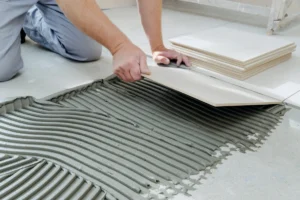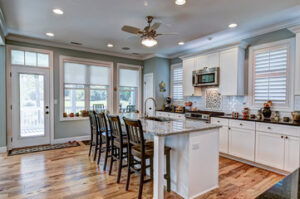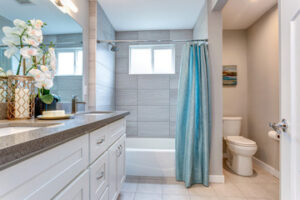Installing tiles requires special tools for cutting and laying the tiles. It’s also important to understand how the subfloor (such as plywood, cement backer board, or uncoupling membrane) must be prepared for tiling.
For best results, begin with two perpendicular chalk lines in the center of the room. Adjust these chalk lines until tile measurements at opposite walls are the same. For more information just visit Bathroom Remodelers Milwaukee.

The first step in laying tile is creating a layout plan for the project. This will help the installer estimate the product needed and identify any potential installation issues caused by architectural features like stairs or transitions. It will also give them a better sense of how the finished floor will look.
The most basic tile layout is a grid pattern, which minimizes the number of cuts and provides a neat, uniform finish. However, this can also result in a dull or sterile space if the tiles need to be more interesting or the design needs to be more complex. Mix and match different tile sizes to create a unique pattern or experiment with a more complex layout, such as herringbone.
When planning a tile layout, it’s important to start in the center of the room and work outwards. It can be tempting to pick a wall and start laying tile there, but this will leave the final product looking crooked. It is best to apply a row of tiles from the center and then move outwards, including some tile spacers between each row.
This method works well for standard tile sizes but can be challenging with larger tiles or ones with an unusual shape. In these cases, taking a piece of graph paper and sketching a detailed layout blueprint is helpful. This will allow you to see if any rows require sliver cuts, which can be difficult to correct later.
When setting irregular tiles, a grid layout is usually the best option. This will ensure that the grout lines are evenly spaced so they won’t appear squished or uneven. If you’re using a natural stone tile, consider the appearance of its unique veining patterns and color variations in your design plan. These features can add a lot of visual interest to the finished room. If you need help with your layout, ask a professional for assistance. They’ll be able to walk you through the process and suggest ways to improve the results.
Before beginning the tile installation, you must ensure the substrate is ready. You should use a cement backer board or a similar material that is also waterproof. It should also be able to support the weight of your tiles. This is important because too much weight on a small area could cause it to crack or even break.
The type of substrate you need will depend on the type of tile and its intended use. If your tile is installed in a moisture-prone area, you may need a special waterproof membrane or self-leveling underlayment. You should also figure out whether you need a transition at doorways available in various styles and materials.
Plywood is acceptable as a substrate for some flooring applications, but it should be exterior-grade and only in dry areas. There are better choices for wall tiles, although they can be used as a layer of underlayment for tile over wood. It is often combined with another layer of underlayment, such as a crack isolation membrane or an uncoupling membrane.
Before installing the tile, ensure you have all the necessary tools and supplies. Most home centers carry most of these, but you’re better off shopping at a specialty tile store, where you can get expert advice and more extensive product selections.
You will also need to choose a thinset mortar, the adhesive that holds the tile in place. Thinset typically combines Portland cement, fine sand, and water. For best results, you should use a trowel that has notches the size of your tile’s thickness to mix it and create grooves in the mortar that will improve adhesion.
Once you’ve mixed the thinset, you should allow it to “slake” for about 10 minutes, which is when it becomes thicker and denser. Then, you can begin laying the tile. Work in easy-to-manage sections, and avoid walking on the newly laid tile until it’s completely set.
Cutting tiles is an essential part of any tiling job. Even the most straightforward jobs require some cutting to fit pieces in corners or work around obstacles. Different cuts need different methods and tools, so planning for the types of cuts you’ll be making is important to ensure a professional-looking finished product and minimize wasted material.
The most common type of cut for tile is a straight cut. To make a straight cut, mark the tile where you want to make your cut with a pencil guideline. Then, use a tile cutter or wet saw to cut off the tile. When using a power tool, always insert notches into the tile before cutting it completely to lessen the chance of chipping. If you don’t have a tile cutter, use a Dremel or an angle grinder with a diamond blade. Notching your tile is also helpful if you work with curved cuts, which can’t be made with snap cutters.
If you’re using a wet saw, follow all manufacturer instructions for safety and accuracy. Also, wear safety goggles and gloves and keep water and dust out of your lungs. Using a hand tool, use industry-grade clamps to hold the tile in place and avoid accidentally chipping it. After the tile has been cut, clean up the edges with a rubbing stone to smooth them out if needed.
When it comes to curve cuts, the best way to do them is freehand, but you can also use a tool called a contour gauge or round objects like cans or lids to help you create a curved line. Then, use a tile cutter to score the tiles where you’ll need to cut them and nip off the excess with a tile nipper. If you’re working with a nipper, squeeze it firmly to make a small nip and not push too hard, or the handle will break the tile.
You can also use a Dremel tool with a diamond blade or an angle grinder with a masonry bit for smaller curved cuts. When working with a curved surface, apply slow and steady pressure to minimize the possibility of breaking the tile.
Professional tile installers work bare-handed, but you should wear gloves if you have sensitive skin. Mixing and working with cement products like thinset can draw moisture from your skin, resulting in burns requiring medical attention. Also, it would be best to consider wearing eye protection when mixing and installing tiles.
The most important step in your tile installation is establishing the layout. A good design ensures that trimmed portions of tiles are symmetrical from side to side and that grout lines are level and plumb. For wall tile projects, layout perpendicular layout lines using chalk to guide your tiling.
Before spreading your thin set, spray the backer board lightly with water to prevent it from soaking up too much of the chipset. This can cause the mortar to dry too quickly, affecting how well it bonds with the subfloor.
Apply the thinset with the notched edge of your trowel, which should be set to a size that matches your tile thickness. After you’ve spread a thin coat, comb it with your trowel to create furrows, which helps release air bubbles underneath the tile. Searching the light set in one direction is crucial because if you move in a circular motion, you’ll leave hollow points under your tiles.
Press it into the thinset with firm, even pressure when laying your first tile. After you’ve placed it, lift it and check for a solid layer of thin set with 80-90% coverage across its back surface. If you don’t have enough thin-set on the back, recheck the consistency of your thin-set and reapply it to the back of the tile.
Use plastic spacers to maintain consistent spacing between rows while laying the tiles. For example, keeping the vertical grout joints offset by exactly half of the tile width is critical if you’re using a running bond pattern.
At this point, you can see the real payoff of your planning efforts. As long as you follow the guidelines in this article, your tile project will look great and last a very long time.

